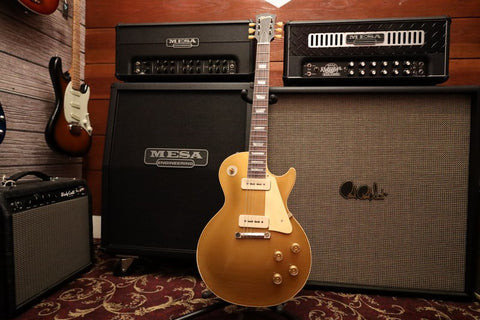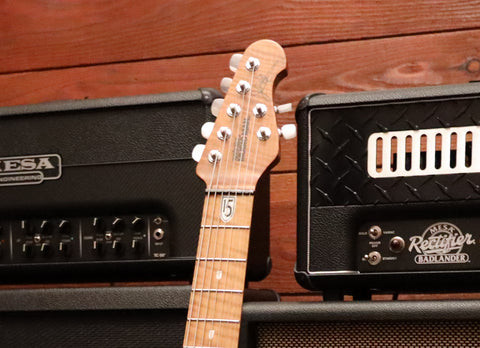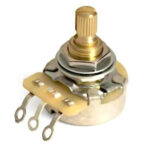The guitar, a timeless instrument cherished across cultures, is defined by its strings. These seemingly simple strands are the very essence of its musical voice, capable of producing a vast spectrum of sounds that resonate with musicians and listeners alike. Understanding the strings of a guitar is fundamental to appreciating its versatility and the diverse musical landscapes it can create.
When considering a guitar, a common first question arises: How Many Strings On A Guitar are there? While the quintessential image might be a six-string guitar, the reality is far more diverse. The number of strings can vary significantly, each configuration offering unique tonal characteristics and playing experiences. Let’s delve into the fascinating world of guitar strings and explore the different string counts found across various guitar types.
Understanding the Basics of a Guitar
A guitar is fundamentally a stringed instrument, where sound is produced by vibrating strings that are stretched over a resonating body. The strings are typically made of materials like steel, nylon, or gut, and are anchored at the bridge and nut of the guitar. By plucking or strumming these strings, musicians create melodies, harmonies, and rhythms.
While six strings have become the most conventional number for guitars, it’s important to recognize that this is not a universal rule. Different musical genres, playing styles, and instrument designs have led to the development of guitars with varying string counts. From the standard six-string to instruments with seven, eight, twelve, or even more strings, each configuration serves a specific musical purpose and offers a unique sonic palette.
Exploring Different Types of Guitars and Their String Configurations
The world of guitars is incredibly diverse, with various types designed for specific musical styles and sonic characteristics. The number of strings is often a key differentiator between these types. Let’s look at some common guitar families and their typical string configurations:
-
Acoustic Guitars: These guitars are designed to produce sound acoustically, without electronic amplification. Within the acoustic guitar family, you’ll find:
- Six-string acoustic guitars: The most common type, used in genres like folk, pop, country, and rock.
- Twelve-string acoustic guitars: Featuring pairs of strings for each of the six courses, creating a rich, chorus-like sound popular in folk and rock music.
-
Electric Guitars: Electric guitars rely on pickups to convert string vibrations into electrical signals, which are then amplified. Common string configurations include:
- Six-string electric guitars: The standard for rock, blues, pop, and many other genres.
- Seven-string electric guitars: Offering an extended lower range, popular in metal and progressive music.
- Eight-string electric guitars: Further expanding the lower range, used in extreme metal and experimental genres.
-
Classical Guitars: Specifically designed for classical and flamenco music, these guitars are characterized by:
- Six nylon strings: Nylon strings produce a warmer, mellower tone compared to steel strings, ideal for classical music.
-
Bass Guitars: Designed to play in the lower frequency ranges, providing the rhythmic and harmonic foundation in music:
- Four-string bass guitars: The most common type, used in virtually all genres.
- Five and Six-string bass guitars: Offering extended lower and upper ranges, popular in jazz, funk, and progressive music.
Understanding these basic categories highlights that the number of strings on a guitar is not arbitrary but rather a deliberate design choice that impacts the instrument’s sound and playing possibilities.
 Image showing different types of guitars including acoustic, electric, and classical guitars, emphasizing the variation in body shapes and materials.
Image showing different types of guitars including acoustic, electric, and classical guitars, emphasizing the variation in body shapes and materials.
The Ubiquitous Six-String Guitar: Why It Became the Standard
When someone mentions “a guitar,” the image that likely comes to mind is the standard six-string guitar. This configuration has become deeply ingrained in musical culture and is considered the quintessential guitar for a vast array of genres. But why did six strings become the norm?
The six-string guitar’s dominance is not merely a matter of chance or tradition; it’s rooted in its exceptional versatility and balanced design. Let’s examine the key reasons why the six-string layout has become so prevalent:
- Optimal Sonic Range: The standard tuning of a six-string guitar (E, A, D, G, B, E, from lowest to highest) provides a wide and musically useful range of notes. This range allows guitarists to play bass lines, chords, melodies, and solos all on a single instrument.
- Versatility Across Genres: The six-string configuration is adaptable to a vast spectrum of musical styles. From the delicate fingerpicking of classical music to the powerful chords of rock and the intricate melodies of jazz, the six-string guitar excels in diverse musical contexts.
- Balance of Complexity and Playability: Six strings offer a sweet spot between harmonic complexity and ease of play. It allows for rich chord voicings and intricate musical passages without becoming overly cumbersome to learn or play. Adding more strings can increase the technical demands on the player.
- Cultural Adoption: The six-string guitar has been embraced by countless musicians and genres across the globe, solidifying its place as the standard. This widespread adoption has created a wealth of learning resources, musical repertoire, and a strong community of six-string players.
In essence, the six-string guitar’s enduring popularity is a testament to its well-engineered design, offering a harmonious balance of sonic range, versatility, and playability that resonates with musicians across diverse musical landscapes.
Venturing Beyond Six: Exploring Guitars with More Strings
While the six-string guitar holds a central position, many musical styles and adventurous guitarists have pushed the boundaries, exploring guitars with expanded string counts. These extended-range guitars offer new sonic territories and playing possibilities.
-
Seven-String Guitars: Adding a seventh string, typically tuned to a low B, expands the guitar’s bass range significantly. This lower register is particularly appealing in genres like metal, djent, and progressive music, allowing for heavier riffs, deeper chugging rhythms, and extended lower harmonies. Seven-string guitars provide a fuller, more powerful sound, especially in heavier musical styles.
-
Eight-String Guitars: Taking the extended range concept even further, eight-string guitars typically add two lower strings, often tuned to F# and B (below the standard six strings). This configuration is prevalent in extreme metal genres and progressive music, offering an incredibly deep and guttural sound. Eight-string guitars are used for creating massive, layered textures and pushing the boundaries of low-end guitar tones.
-
Twelve-String Guitars: In contrast to adding lower strings, the twelve-string guitar expands the sonic texture upwards. It features six courses of strings, with each course consisting of two strings. The lower four courses are typically tuned in octaves (one string tuned an octave higher), while the top two courses are tuned in unison. This configuration creates a rich, shimmering, chorus-like effect that is instantly recognizable. Twelve-string guitars are popular in folk, rock, country, and pop music, adding a lush and full sound to strumming and arpeggiated passages. However, they can be more challenging to play due to the increased string tension and wider neck.
 Image showcasing an eight-string electric guitar, highlighting its wider neck and additional strings designed for extended lower range.
Image showcasing an eight-string electric guitar, highlighting its wider neck and additional strings designed for extended lower range.
The Impact of Alternate Tunings on String Pitch and Musicality
Beyond the physical number of strings, the tuning of those strings plays a crucial role in shaping a guitar’s sound and musical possibilities. Tuning refers to the specific pitches assigned to each string, establishing the foundational tonal framework for playing and composing music. While standard tuning is prevalent, alternate tunings offer guitarists a world of sonic exploration.
-
Standard Tuning: The standard E, A, D, G, B, E tuning provides a logical and versatile framework for playing across the fretboard. It’s the basis for most guitar instruction and musical repertoire.
-
Alternate Tunings: By altering the pitch of one or more strings, guitarists can unlock new sonic landscapes and playing techniques. Alternate tunings can:
- Change Chord Voicings: Different tunings create new chord shapes and inversions, leading to fresh harmonic possibilities.
- Extend Harmonic Range: Dropping the tuning of lower strings, for example, extends the bass range of the guitar.
- Facilitate Specific Techniques: Open tunings, for example, allow for slide guitar playing and fingerpicking styles that are difficult or impossible in standard tuning.
- Inspire New Musical Ideas: The altered sonic landscape of an alternate tuning can spark fresh creative ideas and songwriting approaches.
Common types of alternate tunings include:
- **Dropped Tunings**: Lowering the pitch of the lowest (typically 6th) string, such as Drop D (DADGBE), is common in rock and metal. It allows for easier power chords and a heavier low-end sound.
- **Open Tunings**: Tuning the guitar so that strumming all open strings creates a chord. Open G (DGDGBD) and Open D (DADF#AD) are popular for blues, slide guitar, and fingerstyle playing.
- **Modal Tunings**: Tunings designed to emphasize specific musical modes or scales, such as DADGAD, which is popular in folk and Celtic music, offering a drone-like quality and open, airy sound.Alternate tunings effectively expand the guitar’s sonic palette, offering a vast array of tonal colors and inspiring creative exploration for guitarists across genres.
A Historical Journey: Tracing the Evolution of Guitar String Numbers
To truly understand why the six-string guitar became dominant, and to appreciate the variations in string counts, it’s helpful to look back at the historical roots of the guitar. The instrument we know today is the result of a long evolution, with its ancestors having different string configurations.
-
Early Stringed Instruments: Precursors to the guitar, such as the lute, vihuela, and medieval gittern, exhibited a wide range of string counts, from four to ten or more courses (pairs of strings). These instruments reflected diverse cultural influences and musical aesthetics.
-
The Rise of the Six-String Guitar: The six-string guitar, often attributed to Spain in the 19th century, gradually gained prominence due to its versatility and tonal richness. This configuration offered a balanced range and became well-suited to evolving musical styles.
-
Cultural and Regional Variations: Throughout history, different cultures have embraced various string configurations. For example:
- Baroque Guitars (17th-18th centuries) often had five courses of strings (typically ten strings in total).
- Renaissance Guitars (15th-16th centuries) were commonly four-course instruments.
- Traditional 12-string guitars have roots in Mexican and other folk music traditions, adding a doubled string to each of the six courses.
-
European Influence: The widespread adoption of the six-string guitar in Europe during the 19th century played a significant role in establishing it as the standard.
Understanding the historical context reveals that the number of strings on a guitar is not static but has evolved over time, influenced by cultural preferences, musical demands, and instrument-making innovations.
 Image depicting historical stringed instruments like lutes and early guitars, illustrating the evolution of instrument shapes and string arrangements over centuries.
Image depicting historical stringed instruments like lutes and early guitars, illustrating the evolution of instrument shapes and string arrangements over centuries.
String Material and Construction: Shaping the Guitar’s Voice
Beyond the number of strings, the material and construction of guitar strings are fundamental in determining the instrument’s tonal character. Different materials vibrate in unique ways, producing distinct sonic qualities.
-
Metal Strings: Typically made of steel or alloys like nickel or bronze, metal strings are known for their bright, articulate, and resonant tone. They are used on:
- Electric Guitars: Steel strings are essential for electric guitars as they interact with magnetic pickups to produce amplified sound.
- Acoustic Guitars (steel-string): Steel strings provide a bright, powerful sound ideal for genres like folk, country, rock, and pop.
-
Nylon Strings: Made from nylon polymers, these strings produce a warmer, mellower, and softer tone compared to metal strings. They are primarily used on:
- Classical Guitars: Nylon strings are essential for the characteristic warm and nuanced sound of classical and flamenco guitars.
-
String Construction and Alloys: The specific alloys and construction techniques used in making strings further refine their tonal properties. For example:
- Phosphor Bronze strings: Offer a warm, rich, and full tone, popular for acoustic guitars.
- 80/20 Bronze strings: Provide a brighter and more brilliant tone, also used on acoustic guitars.
- Coated strings: Have a thin polymer coating that extends string life and can subtly alter the tone.
-
String Gauge (Thickness): The thickness of guitar strings also significantly impacts tone and playability.
- Heavier gauge strings: Produce a fuller, louder tone with more sustain, but can be harder to play (require more finger strength).
- Lighter gauge strings: Are easier to play, bend, and fret, and produce a brighter tone, but may have less sustain and volume.
The choice of string material and gauge is a crucial factor in shaping the overall sound and playing experience of a guitar, directly influencing the instrument’s voice and suitability for different musical styles.
Genre-Specific String Preferences: Matching String Count to Musical Style
Different musical genres often gravitate towards specific guitar types and string configurations that best suit their sonic aesthetics and playing techniques. The number of strings on a guitar becomes a defining element within these genre-specific preferences.
-
Classical and Flamenco: These genres almost exclusively use six-string nylon-string guitars. The warm, mellow tone of nylon strings and the six-string layout are perfectly suited for the intricate fingerpicking, melodic complexity, and nuanced dynamics of classical and flamenco music.
-
Rock and Metal: These genres showcase a wider range of string preferences:
- Six-string electric guitars: Remain foundational for rock and traditional metal, offering versatility for rhythm and lead playing.
- Seven and Eight-string guitars: Have become increasingly popular in metal subgenres like djent, progressive metal, and extreme metal, providing extended lower ranges for heavier, more aggressive sounds.
-
Jazz: Jazz guitarists primarily utilize six-string guitars, often electric archtops or semi-hollow bodies. The six-string layout is well-suited for complex chord voicings, improvisational melodies, and the sophisticated harmonic language of jazz.
-
Country and Bluegrass: These genres favor the bright, twangy sound of six-string steel-string acoustic guitars. The six-string configuration and steel strings are integral to the characteristic sound of country and bluegrass flatpicking, strumming, and fingerpicking styles.
-
Folk and Pop: These genres embrace a variety of string configurations:
- Six-string acoustic guitars: Are widely used for strumming, fingerpicking, and singer-songwriter accompaniment.
- Twelve-string acoustic guitars: Add a rich, chorus-like texture to folk and pop arrangements, particularly for strumming and arpeggiated patterns.
Understanding these genre-specific preferences can guide guitarists in selecting the appropriate string count and guitar type to achieve the desired sound and playing experience for their chosen musical style.
Conclusion: The Harmonious Diversity of Guitar Strings
Our exploration into the world of guitars reveals that the answer to “how many strings on a guitar?” is wonderfully diverse. While the six-string guitar holds a central and iconic position, the guitar family encompasses a rich spectrum of string configurations, each offering unique sonic possibilities and playing experiences.
From the standard six-string acoustic to the extended-range eight-string electric and the shimmering twelve-string acoustic, the number of strings is a deliberate design choice that shapes an instrument’s voice and its suitability for different musical styles. Whether you’re drawn to the traditional versatility of the six-string, the extended depths of seven or eight strings, or the lush textures of twelve strings, the world of guitars offers a string configuration to match every musical aspiration.
Now, it’s time to let your own musical journey unfold! Explore the different types of guitars, experiment with string counts, and discover the sounds that resonate with your creative spirit.
- Ready to Play? Pick up a guitar, any guitar, and let the strings guide your musical exploration.
- Want to Learn More About Guitar Care? Dive into our comprehensive Guitar Maintenance Guide to master string changes and keep your instrument in top condition.
Continue Your Guitar Adventure
Visit our Resources Section for in-depth articles on various guitar types and expand your guitar vocabulary with our detailed glossary. With knowledge and the right strings beneath your fingers, your guitar story is just beginning.
Keep exploring, keep playing, and let the strings sing!
Share the Knowledge:
[

